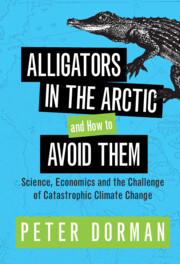 Alligators in the Arctic and How to Avoid Them
Alligators in the Arctic and How to Avoid Them Book contents
- Alligators in the Arctic and How to Avoid Them
- Alligators in the Arctic and How to Avoid Them
- Copyright page
- Dedication
- Contents
- Figures, Maps and Tables
- Preface
- Introduction
- 1 Carbon Accounting for Planet Earth
- 2 The Risks of Climate Change, or Why Carbon Budgets Need to Be Binding
- 3 Measurement
- 4 It’s about Fossil Fuels
- 5 Costs and Consequences
- 6 The Carbon Policy Toolkit
- 7 The Global Dimension
- 8 Political Economy for Alligators
- Appendix: Demystifying the Economics of Climate Change
- Notes
- References
- Index
1 - Carbon Accounting for Planet Earth
Published online by Cambridge University Press: 14 July 2022
- Alligators in the Arctic and How to Avoid Them
- Alligators in the Arctic and How to Avoid Them
- Copyright page
- Dedication
- Contents
- Figures, Maps and Tables
- Preface
- Introduction
- 1 Carbon Accounting for Planet Earth
- 2 The Risks of Climate Change, or Why Carbon Budgets Need to Be Binding
- 3 Measurement
- 4 It’s about Fossil Fuels
- 5 Costs and Consequences
- 6 The Carbon Policy Toolkit
- 7 The Global Dimension
- 8 Political Economy for Alligators
- Appendix: Demystifying the Economics of Climate Change
- Notes
- References
- Index
Summary
The Earth surface carbon cycle consists of regular flows between the major sinks: atmosphere, ocean, soils and biota. It is in balance, except for flows to and from long-term storage (methane formations, deep ocean, lithosphere), which comprise the deep Earth carbon cycle. At the beginning of life in earth history, about 500 million years ago, the atmosphere was carbon-rich, and Earth temperatures were vastly hotter than today. Over time most of this carbon was withdrawn from the surface carbon cycle through ocean sedimentation, reactions with weathering rock and migration of organic matter to the lithosphere, where they were transformed into fossil fuels. This eventually produced the temperate Earth, which facilitated human evolution, but now, by extracting and burning fossil energy, humans are recreating conditions for the hotter Earth of earlier times. These direct carbon emissions can be amplified by feedback mechanisms, whereby initial warming releases carbon stored in formerly stable methane deposits and alters the carbon cycle so as to increase the size of the atmospheric sink relative to other sinks or changes in the Earth’s albedo. The politics of controlling emissions is further complicated by lags in warming and subsequent climate impacts.
Keywords
- Type
- Chapter
- Information
- Alligators in the Arctic and How to Avoid ThemScience, Economics and the Challenge of Catastrophic Climate Change, pp. 17 - 36Publisher: Cambridge University PressPrint publication year: 2022


